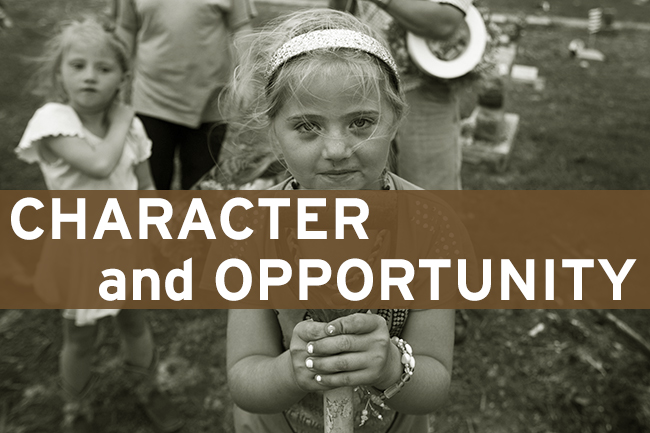In this essay from the Center on Children and Families’ Essay Series on Character and Opportunity, Jen Lexmond explains that the social construction of gender limits our social mobility, perhaps more than any other structure, because it feeds the root, the very source, of our character.
“The female is a female by virtue of a certain lack of qualities”
-Aristotle (quote in Simone de Beauvoir’s The Second Sex)
Emma Watson, actress and UN Goodwill Ambassador, launched a new campaign, #HeForShe. In a landmark speech to the UN on gender equality she argued that the pressure for men to be ‘masculine’ and for women to be ‘feminine’ is limiting self-expression and opportunity for everyone.
Much attention is paid by policy makers to structures of class, race, and income that inhibit social mobility: our freedom to change, adapt, or improve our position in society. There has been less focus on how individual’s own qualities, capacities, and dispositions shape their life chances. But intuitively, we know that a resilient, motivated, and determined individual—no matter what socio-economic situation they find themselves in—will fare differently to someone who lacks confidence, struggles to control their emotions, and gives up easily. Individual character evidently shapes social mobility.
Far from being fixed or an accident of birth, many of these character traits are developed, at the start of life through a combination of home environment and parenting, and throughout life by wider social and cultural structures. Character development is thus a key part of any strategy to deliver a more socially mobile society.
The social construction of gender limits our social mobility, perhaps more than any other structure. because it feeds the root, the very source, of our character. It is typically seen as the basis of social identity, with most societies having a fairly clear assignment of gender attributes for each of the sexes. Developmental accounts of gender suggest it is formed in the early years when young children first grasp the concept of the gender binary (in other words that there are two—feminine and masculine—and that they are opposites), learn about roles and stereotypes (pink and blue), identify with parents (like mother like daughter), and form preferences (dolls vs. soccer). By the age of five or six, when children are starting at school and spending more time with peers, gender roles are consolidated and at their most rigid.
Language and linguistics, the mass media, and the roles adopted by parents and siblings at home are all key sources of information about gender that young children soak up, and in turn internalise, model, and integrate into their own identities. But the images of ‘boy’ and ‘girl’ presented to young children are limiting right from the outset, at a time when brains are most ‘plastic’ or open to influence. These are the ‘headline’ messages being broadcast to children about their gender:
Boys:
- are the majority
- have a range of ambitions and aspirations
- are primarily active in taking on challenges
- and achieving goals
- are the protectors of the ‘weaker sex’
- are rewarded and do well when they face up to challenges
- are ‘fixers’
Girls:
- are a minority
- are primarily concerned with finding romantic love
- are often passive, and look to others to fulfill their wishes
- are ‘saved’ by male heroism
- are rewarded and do well when they’re pretty
- are ‘fixed’
Between 2006 and 2011, the Geena Davis Institute on Gender in the Media conducted a study of Examining 11,927 speaking characters in 129 top-grossing family films, 275 prime-time programs (including ABC, NBC, Fox, Cartoon Network, Disney Nickelodeon), and 26 children’s TV shows across key networks. In family films, the study found an almost 3 to 1 ratio of male to female characters. Only a quarter of narrators were female. A mere tenth of films had a gender balanced cast. There was also a striking disparity in presentation – not only in the proportion of male v female characters, nor in how primary their roles were (how frequently they speak, how integral they were to the story or plot) – but also, crucially, in their personal attributes, in other words, their ‘character’.
Female characters were portrayed with more exposed skin, thinner bodies, and their physical attractiveness was referred to more often. ‘Adornment, enticement, or with an inclination to romance’ remained the key motivation of female characters. Even within this drive towards finding love, female characters tended not to try to fulfil their aspiration through action – initiating plans or setting events in motion in order to achieve a goal. The majority were passive, or ‘daydreamers’ with an idea of romantic love in mind but little intention or resolve to realise their desires.
These gender profiles function as powerful cues, especially to younger viewers, providing positive and negative reinforcements of behavior, including incentivising action for boys and passivity for girls. As these messages are repeated – not just through media, but through peers and parents, toys, and books – they lead not just to changes in behaviour, but the formation of habits, tastes, and interests. In short, they shape our character.
We know very well the traditionally measured ‘gaps’ that the construct of gender has led to: earnings and pay, wealth and assets, land ownership, positions of authority, representation in different occupational sectors, a public/private division of labour. We know that girls and women are the biggest losers here, but we also know that boys and men are negatively affected too: the pressure of masculinity is eroding men’s health and wellbeing. In the UK today, suicide is the leading cause of death amongst men age 20-49.
One of the most inspiring early results of Watson’s call to action came in the form of an open letter from a 15 year old British school boy:
By using words such as ‘girly’ or ‘manly’ we inadvertently buy into gender stereotyping. We play with toys designed for our gender, we play different sports based on gender, we often go to segregated schools. And yet it takes some effort for people to acknowledge the existence of gender inequality and the injustice it entails for both sexes. If we want equality, it will take more effort than paying women the same as men, or giving women equal opportunities. We must all make an active decision to change our language. We must stop pressuring each other to fit stereotypes which more often than not leaves us feeling repressed and unable to express ourselves. We must not let gender define us.
The self-limiting norms of gender cramp the development of individual character, and thereby reduce freedom, opportunity and fairness. For women, most obviously, but in the end for us all.


